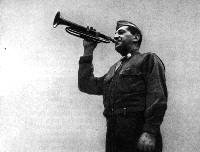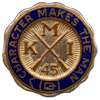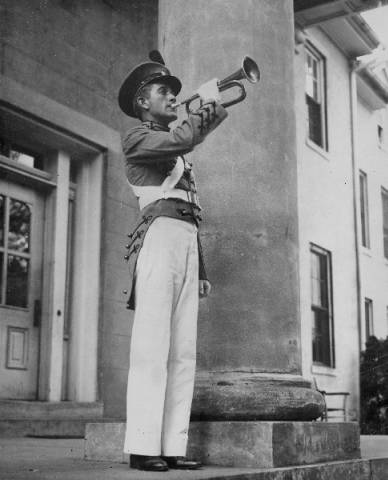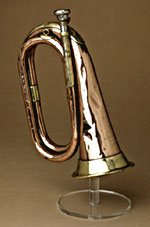
|
1935 Herald-Post collection, University of Louisville Photographic Archives. Bugle calls are musical signals that announce scheduled and certain non-scheduled events on an Army installation. Scheduled calls are prescribed by the commander and normally follow the sequence shown below. Non-scheduled calls are sounded by the direction of the commander.
DAILY SEQUENCE OF BUGLE
CALLS:
[Source: www. Bands.Army.mil }
Originating from a drum call more than two centuries ago, Reveille was intended to rouse soldiers for the duty day and notify sentries to cease night challenging, In 1812, Reveille was a drum call, but as time passed it came to mark when the flag was raised in the morning and honors paid to it, Since it is no longer only a call for soldiers to rise in the morning, it is proper for all military and civilian personnel to afford honors to the flag during these ceremonies." "Retreat takes place at 6 p.m. (5 p.m. during late fall and winter) each day with a cannon firing and the playing of the National Anthem or the bugle call "To the Colors" if a band is not available," The European traditions of Reveille and Retreat were imported to this country, but the bugle calls played today bear little or no likeness to those used by our European counterparts." This information was
provided by Staff Sgt. Nicholes Dyer, Honor Guard Platoon.
http://www.usma.edu/publicaffairs/PV/030912/Reveille.htm |
||||||||||||||||||||||||||||||||||||||||||||||||||||||||||||
Like the voice of the faithful town crier from days of old, military bugle calls awaken sleepy soldiers, announce meal time, proclaim the duty day's end and, as only the Army could, orchestrate a gentle reminder of lights out with a nostalgic lullaby. Old-timers are often eager to share stories centered around the Army's bugle calls. There's the tale of the meticulous soldier who religiously set his watch, and the rest of the clocks in his house, to First Call at 0730 hours or of the dedicated Army wife who equated Assembly with children's nap time at 1300 hours. Then there's the complaint that calls weren't loud enough for those hard-core personnel strictly regulating their day in accordance with the sacred tunes. Many soldiers and veterans today find themselves deeply affected by these eloquent musical tones. Lona Rogers, a United States Military Academy Preparatory School cadet candidate at Fort Monmouth, N.J., is up long before Reveille but says the shrill morning call to duty definitely boosts her motivation. "It's your sign to wake up," Rogers said. "You have a job to do, so let's go do it." Members of Fort Monmouth's Retiree Group, who went through basic training there more than 50 years ago, clearly remember Reveille as a dreaded "screeching noise," and swear the only thing worse was being thrown out of bed by a drill sergeant if you hadn't responded to that first wake-up call. Pay Call and Mail Call also caused quite a scramble back then, according to group member Joe Rankin, a World War II veteran. And, he said, no other organization in the world quite knows how to end a duty day like the U.S. Army -- with the sharp, dignified tones of Retreat complemented by soldiers paying their respects. Ed Devlin*, Fort Monmouth's director of training, plans, and mobilization, believes the custom of halting a military installation's operations to honor the Retreat Ceremony means more than just recognizing that work is over for the day. "It's parallel to stopping and smelling the roses as you go through life," Devlin said. "Bugle calls keep us in touch with things that were important in the past and that are important now." Although it's been more than 50 years since Robert Peterson began his 19th bombing mission over Germany, he agrees with Devlin's sentiment. That mission became his last when he was shot down and spent the next 18 months in a prisoner-of-war camp. "It wasn't until I saw a Retreat Ceremony that I knew I was home," Peterson said. SFC Alan Templeton, also of DTPM, was assigned to the Berlin Brigade over a decade ago. He says the Retreat Ceremony there during the Cold War was an extraordinary experience in his career. "We were located quite close to the East German guard towers and I remember seeing them look down while the bugle was playing, and I couldn't help feeling they were truly envious." For the retiree group and the cadet candidates at Fort Monmouth, Taps seems to bring on the widest range of emotions. "Taps really has 'Army' written all over it," said cadet Dan Russo. "I believe, of all the bugle calls, that's the one that makes you think and remember." For Jeremy James, a West Point cadet, hearing Taps for the first time was exhilarating. "My heart was beating happily when I heard the song that night because I knew I'd succeeded in what I set out to do. That day, I'd done more push-ups than I'd ever done in my life and I realized I was on the way to my future." But coming out of the Depression and suddenly being thrust into a world war at the age of 16 brought an entirely different emotion to Tom Helmick, a Navy veteran. "At the end of that first day at basic, I was lying in my bunk, and Taps began playing," he explained. "That was the first time I'd ever been away from home, and hearing those lonely, solemn tones brought a lump to the back of my throat that I can feel today." Taps, the melody that has touched countless service men and women, was created by Gen. Daniel Butterfield of the federal Army of the Potomac in 1862. With no musical ability, Butterfield enlisted the talent of the brigade bugler, Oliver W. Norton, to signal the end of the day. Taps debuted that July at Harrison's Landing, Va. Taps was chosen for a military funeral, instead of the customary three volleys, because of the proximity of the enemy. The new custom quickly spread and eventually was confirmed by orders. Army bugler Sgt. Mark Barrett, who has played Taps at several military funerals, says it's the hardest part of his job and carries the greatest responsibility. "It's that final goodbye to a friend, the final hurrah, and you want it to be absolutely perfect," Barrett said. It was during a tour at West Point that Army Chaplain (Lt. Col.) Terry Dempsey learned the words to Taps and began reading them with the benediction at the end of military funerals: "Day is done. Gone the sun, From the lake, From the hill, From the sky. All is well, Safely rest, God is nigh. "Thanks and praise, For our days 'Neath the sun, 'Neath the stars, 'Neath the sky. As we go, This we know: God is nigh." "I felt it was appropriate, since it not only closes the soldier's day, but is the final goodbye, closing this phase of his life. I can't think of any words more fitting for a soldier's last farewell," Dempsey said. Helmick not only appreciated the meaning of the bugle calls, but also appreciated buglers such as Barrett. "Back then those calls weren't just sounds, they weren't just music, they meant something. And they didn't come out of a tape recorder. They were played professionally and proudly by a living, breathing soldier," said Helmick. Talented buglers have indeed been replaced by machines at most Army posts. At Fort Monmouth the bugle calls are played on a digital recorder. Seven times a day, Sunday through Saturday and holidays, Reveille rings out at 0600 hours followed by Recall, Mess Call, Assembly, Retreat and Tattoo, with Taps at 2200 hours. Regardless of how the bugle calls are played and whether you prefer Reveille or Retreat, it's comforting to know the calls are still treated with the honor, respect and attention each deserves. *Ed Devlin is currently a member of the Civil War (2nd New Jersey) reenacting brigade. |
||||||||||||||||||||||||||||||||||||||||||||||||||||||||||||
 "HISTORY OF "TAPS" (Military District of Washington Fact Sheet: Origins of "Taps) "One day in July 1862 when the Army of the Potomac was in camp at Harrison's Landing on the James River, Virginia, resting and recruiting from its losses in the seven days of battle before Richmond, Gen. Butterfield summoned the writer to his tent, and whistling some new tune, asked the bugler to sound it for him. This was done, not quite to his satisfaction at first, but after repeated trials, changing the time of some of the notes, which were scribbled on the back of an envelope, the call was finally arranged to suit the general. "He then ordered that it should be substituted in his brigade for the regulation "Taps" (extinguish lights) which was printed in the Tactics and used by the whole army. This was done for the first time that night. The next day buglers from nearby brigades came over to the camp of Butterfield's brigade to ask the meaning of this new call. They liked it, and copying the music, returned to their camps, but it was not until some time later, when generals of other commands had heard its melodious notes, that orders were issued, or permission given, to substitute it throughout the Army of the Potomac for the time-honored call which came down from West Point. In the western armies the regulation call was in use until the autumn of 1863. At that time the XI and XII Corps were detached from the Army of the Potomac and sent under command of Gen. Hooker to reinforce the Union Army at Chattanooga, Tenn. Through its use in these corps it became known in the western armies and was adopted by them. From that time, it became and remains to this day the official call for "Taps." It is printed in the present Tactics and is used throughout the U.S. Army, the National Guard, and all organizations of veteran soldiers. Gen. Butterfield, in composing this call and directing that it be used for "Taps" in his brigade, could not have foreseen its popularity and the use for another purpose into which it would grow. Today, whenever a man is buried with military honors anywhere in the United States, the ceremony is concluded by firing three volleys of musketry over the grave, and sounding with the trumpet or bugle "Put out the lights. Go to sleep"...There is something singularly beautiful and appropriate in the music of this wonderful call. Its strains are melancholy, yet full of rest and peace. Its echoes linger in the heart long after its tones have ceased to vibrate in the air."
TAPS Day is done ....... Gone the sun ....... From the lakes ... From the hills ... From the skies ....... All is well ....... Safely rest ....... God is nigh ........ Fading light ....... Dims the sight ........ And a star ... Gems the sky ... Gleaming bright ....... From afar ....... Drawing nigh ....... Falls the night ....... Thanks and praise ....... For our days ....... Neath the sun ... Neath the stars ... Neath the sky ....... As we go ....... This we know ....... God is nigh ........ |
||||||||||||||||||||||||||||||||||||||||||||||||||||||||||||
| Almost every
day when
I check my e-mails, I get a message or two asking about or forwarding a
story for my comment or enlightenment. It starts with, "It
all began during the Civil War..."
and goes on to relate the story of a Union Captain Ellicombe and how he
finds his wounded Confederate son on a battlefield. The story is
that the music of Taps is found in the pocket of the young man and
that's
how the call came into being. It is a heartwarming and poignant
story…
This story, of course, rates up there with the one that Colonel Oliver North tried to warn us about Osama Bin Laden during Congressional hearings, the one that Lee Marvin and Captain Kangaroo (Bob Keeshan) met as Marines on Iwo Jima, and the one about a Vietnam POW being ratted out by Jane Fonda on her visit to Hanoi. It is a yet another MYTH that makes it way around thanks to the Internet. Bad history, and we get to see a lot of it, needs to be corrected. The story of Captain Robert Ellicombe and his Confederate son is a myth, a fake, a tall tale, a good story to tell around the old campfire, but a story that holds no truth whatsoever. This is one of those stories that is reprinted and forwarded to others and makes its way around the Internet around Memorial Day, Independence Day and Veterans Day. The story gets printed in papers, newsletters, and, sad to say, even on some military websites as the true version of how the bugle call of Taps came into existence. I have sounded the call over 2,000 times as bugler in national cemeteries and at hundreds of memorial services. I am also a bugle historian who has spent much time researching this topic. I was the curator of the Taps Exhibit at Arlington National Cemetery and am a Civil War reenactor. I, along with other history buffs, have researched the real story and have tried to squash this myth. You can read the true story of the creation of Taps elsewhere on this site. Here is the MYTH: " We in the United States have all heard the haunting song, 'Taps.' It's the song that gives us that lump in our throats and usually tears in our eyes. But, do you know the story behind the song? If not, I think you will be interested to find out about its humble beginnings. Reportedly, it all began in 1862 during the Civil War, when Union Army Captain Robert Ellicombe was with his men near Harrison's Landing in Virginia. The Confederate Army was on the other side of the narrow strip of land.During the night, Captain Ellicombe heard the moans of a soldier who lay severely wounded on the field. Not knowing if it was a Union or Confederate soldier, the Captain decided to risk his life and bring the stricken man back for medical attention. Crawling on his stomach through the gunfire, the Captain reached the stricken soldier and began pulling him toward his encampment. When the Captain finally reached his own lines, he discovered it was actually a Confederate soldier, but the soldier was dead. The Captain lit a lantern and suddenly caught his breath and went numb with shock. In the dim light, he saw the face of the soldier. It was his own son. The boy had been studying music in the South when the war broke out. Without telling his father, the boy enlisted in the Confederate Army. The following morning, heartbroken, the father asked permission of his superiors to give his son full military burial despite his enemy status. His request was only partially granted. The Captain had asked if he could have a group of Army band members play a funeral dirge for his son at the funeral. The request was turned down since the soldier was a Confederate. But, out of respect for the father, they did say they could give him only one musician. The Captain chose a bugler. He asked the bugler to play a series of musical notes he had found on a piece of paper in the pocket of the dead youth's uniform. This wish was granted. The haunting melody we now know as 'Taps' used at military funerals was born."
So where did this myth come from? I have traced this tale to a Ripley’s “Believe It Or Not” story that Robert Ripley created for his short-lived TV program in 1949. This is chronicled in the book Ripley, the Modern Marco Polo: The Life and Times of the Creator of “Believe It Or Not” by Bob Considine, published by Doubleday & Co. in 1961. As Considine wrote: "The denouement of this is a coincidence incredible even by Rip’s standards." The Taps myth took on a life of its own and was even printed as fact in an Ann Landers or Dear Abby column. A retraction was later printed. It has acquired a renewed life on the Internet and is spread by many unsuspecting but well-meaning people who believe it to be true. It is unfortunate to see it on websites, especially military and veterans’ sites that should know better. It is hoped that those who are interested in history will spread the word to stop the myth. Jari Villanueva | ||||||||||||||||||||||||||||||||||||||||||||||||||||||||||||
|
Tattoo originated during the Thirty Years War, 1618-1648, and in German was called "Zapfenstreich." At 9:00 P.M., as the call was sounded, all bungs (zapfen) had to be replaced in their barrels, signifying the end of nightly drinking. The provost guard then drew a chalk line (streich) across the bung so that it could not be reopened without evidence of tampering. Tattoo is the longest U.S. Army call, consisting of twenty- eight measures. The first eight are from the French call "Extinction de Feux" and the last twenty measures are from the British "First Post" - in turn adapted from an old Neapolitan Cavalry call "Il Silencio". RETREAT: Then The bugle call sounded at retreat was first used in the French Army and dates back to the crusades. When you hear it, you are listening to a beautiful melody that has come to symbolize the finest qualities of the soldiers of nearly 900 years. Retreat has always been at sunset and its purpose was to notify the sentries to start challenging until sunrise, and to tell the rank and file to go to their quarters and stay there. In our times the ceremony remains as a tradition. When you are outdoors and hear retreat played, you face toward the flag if you can see it and stand at parade rest. If the flag is not within sight. then face toward the music. RETREAT: Now Retreat is a daily ceremony held at all army installations as the national flag is lowered at the end of the work day. It is scheduled at a definite time in late afternoon: the precise time left to the discretion of the installation commander. At fort monmouth the time designated is 1700 hours (5:00 pm). The ceremonies of retreat in the afternoon, coupled with reveille in the morning constitute a dignified homage to the national flag from its raising to its lowering. The bugle call "retreat" is sounded just before the actual lowering of the flag. At the last note of this call, a cannon is fired. Then, if a band is present, the national anthem will be rendered. In the absence of a band, the bugle call "to the colors" is substituted. As the anthem, or "to the colors" is sounded, the flag is lowered. The lowering of the flag will be regulated so as to be completed with the last note of the music. All personnel within sight or sound of the ceremony will come to attention and render the appropriate salute, facing the flag. Vehicular traffic will come to a halt, and the driver or individual in charge of the vehicle will dismount to render honors. The retreat ceremony is known to have been in use in the American army since the revolutionary war. At that time it was sounded by drums-the normal musical instrument found in the infantry units of that period. The history of the evening gun is much older. Initially it was not connected with a flag lowering. One legend has it that it was initially fired to drive away evil spirits. That would put its origin back in the middle ages when gunpowder was introduced into europe, and much earlier in the orient. It seems logical in more modern times that the firing of a gun near sunset was intended to call the troops back to the fort or camp from their fatigue duties of the day. The booming of the cannon could be heard at a greater distance than the sound of either drum or bugle. Finally, a parade can be held in conjunction with the retreat ceremony. The combination of ranks of smartly uniformed troops, the sound of the evening gun and the band playing the national anthem constitutes one of the most inspiring of United States Army ceremonies. Source: Federation of American Scientists http://www.fas.org |
 |
Kentucky
Military Institute www.kmialumni.org Send e-mail to: kmimail@kmialumni.org Copyright © All rights reserved. |
 |

